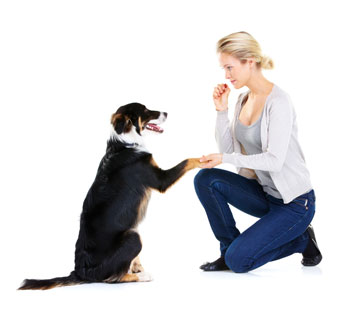How to Teach a Dog to Shake

Spending time with your dog while training him to follow new commands is fun for both of you. Not only that, but it serves to bond you and your dog even further through shared time and the praise you give your dog for doing well.
Shake is a fun trick for dogs to know how to do. Here, we've listed the steps you'll take when teaching your dog to shake.
Use Positive Reinforcement to Teach Your Dog to Shake
Before beginning, you may wish to review the article "Clicker Training for Dogs: An Overview" to determine whether clicker training is right for you and your dog.
Here are the steps to teach your dog to shake using positive reinforcement techniques:
- First, ask your dog to sit. If your dog still needs to learn the sit command, go here: "How to Teach Your Dog to Sit ."
- Hold a treat in your hand and show it to your dog, then close your hand over it.
- Hold the hand out toward your dog and wait. He is likely to make some attempt to get the treat from your hand. If he gets up, ask him to sit and try again.
- Once your dog makes a move to lift his paw toward your hand, say "yes" or click the clicker and give him the treat.
- Moving slowly, gradually work toward having your dog lift his paw higher, toward your hand, before giving him the treat. You may need to eventually lift his paw yourself, gently, to show him what you want.
- Introduce a verbal command such as "shake" or "give paw" once your dog is reliably lifting his paw toward your hand.
- Next, begin using the verbal command before your dog starts to raise his paw.
- Eventually, work toward completing the trick with your dog without having a treat in your hand.
General Information for Dog Training
To get the most out of your training sessions with your dog, follow these tips:
- Don't train for more than 10 minutes at a time.
- Play with your dog before starting a training session, to get some of his energy out so he can more easily focus.
- It can help to train your dog when he is a bit hungry, so your training treats entice him to cooperate more.
- Always bring a positive attitude to your training sessions. Your dog will respond better if you are happy and patient. Learn more: "Dogs Don't Trust Angry People."
You May Also Like These Articles:
Tips for the First Few Weeks with Multiple Dogs
How Do You Stop a Dog from Barking?
How to Teach Your Dog to Play Tug-of-War
How to Teach a Dog to Play Fetch Using Clicker Training
Dog Training Tips: Using Treats Properly
Disclaimer: This website is not intended to replace professional consultation, diagnosis, or treatment by a licensed veterinarian. If you require any veterinary related advice, contact your veterinarian promptly. Information at DogHealth.com is exclusively of a general reference nature. Do not disregard veterinary advice or delay treatment as a result of accessing information at this site. Just Answer is an external service not affiliated with DogHealth.com.
Notice: Ask-a-Vet is an affiliated service for those who wish to speak with a veterinary professional about their pet's specific condition. Initially, a bot will ask questions to determine the general nature of your concern. Then, you will be transferred to a human. There is a charge for the service if you choose to connect to a veterinarian. Ask-a-Vet is not manned by the staff or owners of DogHealth.com, and the advice given should not delay or replace a visit to your veterinarian.



